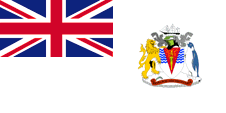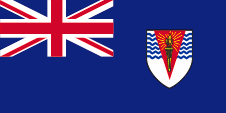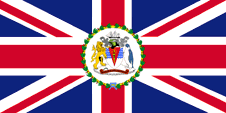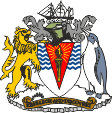Britisches Antarktis-Territorium |
|
|
|
| Übersicht – Contents: | |
Britisches Antarktis-Territorium |
|
|
|
| Übersicht – Contents: | |
| Erklärung: | Explanation: |
| Das Britische Antarktis-Territorium ist international nur teilweise anerkannt. Der britische Besitz dieses Gebietes geht auf die Inbesitznahme der Süd-Shetland-Inseln im Jahre 1819, der Süd-Orkney-Inseln im Jahre 1821 und der Halbinsel Grahamland im Jahre 1832 zurück. Der bis heute bestehende britische Besitz der Falklandinseln, der Insel Südgeorgien und der Süd-Sandwich-Inseln (Südantillen) erlaubte Großbritannien die Beanspruchung eines Ganzen Sektors auf Antarktika im Jahre 1908, zwischen 20° und 80° W. Zwischen 1940 und 1942 begannen Chile und Argentinien Ansprüche auf das britische Gebiet zu erheben, die nicht nur wegen des britischen Besitzes der Südantillen haltlos waren und sind. Der Antarktisvertrag vom 01.12.1959 frohr alle Ansprüche ein, und Besitz unterhalb 60° S wird auf Landkarten nicht mehr dargestellt. | The British Antarctic
Territory, is internationally only partially recognized. The British possession of this
area goes back to the appropriation of the South Shetland Islands in 1819, the South
Orkney Islands in 1821 and the peninsula of Graham Land in 1832. The until today existing British possessions of the Falkland Islands, South Georgia Islands and the South Sandwich Islands (South Antillas) allowed the appropriation of a whole sector of Antarctica, between 20° and 80° W, in 1908. Between 1940 and 1942, Chile and Argentina raised claims on the British territory, which were without foundation, not only because of the property of the British South Antillas. The Antarctic Treaty of 1st of December in 1959 froze all claims, and helds below 60° S become no longer displayed on maps. |
| Die Britischen Besitzansprüche auf den Antarktischen Sektor sind durch Australien, Frankreich, Neuseeland und Norwegen anerkannt, jedoch nicht von den Vereinten Nationen, Argentinien, Chile, USA und Russland und vielen anderen Ländern. | The British claimed
ownership of the Antarctic sector are recognized by Australia, France, New Zealand and
Norway, but not by the United Nations, Argentina, Chile, USA and Russia and many other
countries. |
| Quelle/Source: Volker Preuss | |
|
|
|
Flaggen – Flags: |
|
 |
Nationalflagge – national flag, Seitenverhältnis – ratio = 1:2, Quelle/Source nach/by: Flags of all Nations |
 |
Flagge der Regierung – governmental flag, Seitenverhältnis – ratio = 1:2, Quelle/Source nach/by: Flags of all Nations |
 |
Flagge des Kommissars für das B.A.T. – flag of the Commissioner of the B.A.T., Seitenverhältnis – ratio = 1:2, Quelle/Source nach/by: Flags of all Nations |
|
|
|
Bedeutung/Ursprung der Flagge – Meaning/Origin of the Flag: |
|
| Die Nationalflagge des Britischen Antarktis-Territoriums (BAT) ist ein sogenannter White Ensign", ein weißes Flaggentuch mit einer Flaggendarstellung – dem britischen Union Jack – in der Oberecke. Der Union Jack weist auf die Verbindungen zu Großbritannien hin. | The national flag of the British Antarctic Territory (BAT) is the so called "White Ensign", a white flag cloth with a flag design – the British Union Jack – in the upper staff quadrant. The Union Jack points to the connexions to the United Kingdom. |
Großbritannien hatte
in Jahr 1864 ein Flaggensystem eingeführt, in dem:
Seit 1865 durften Schiffe von Kolonialregierungen einen Blue Ensign mit einem Badge (Abzeichen) im fliegenden Ende führen. Die jeweiligen Regierungen sollten entsprechene Bagdes zur Verfügung stellen. Handelsschiffe und seefahrende Privatpersonen aus Kolonien dürfen nur dann einen Red Ensign mit Badge führen, wenn von der britischen Admiralität eine entsprechende Erlaubnis für die Kolonie erteilt wurde. |
The United Kingdom introduced a flag system in 1864 in which:
Since 1865 ships of colonial governments were permitted to fly the Blue Ensign with a badge in the flying end of the flag. The respective governments were asked to design appropriate badges. Merchant ships and seafaring persons from colonies were only permitted to use the Red Ensign with a badge, then also named Civil Ensign, if permission has been given to the respective colony by the British admiralty. |
| In Ermangelung ständiger Einwohner im BAT liegt eine solche Erlaubnis nicht vor. Wieso aber das BAT als Nationalflagge einen "White Ensign" führt, ist unbekannt. | Because there BAT are no permanent inhabitants, such a permission in missing. But why the BAT uses as national flag a ”White Ensign”, is unknown. |
| Bei britischen Kolonien und abhängigen Gebieten wurde die Darstellung des Badge (bzw. Wappen) sehr häufig im fliegenden Ende des Ensigns auf einer weißen Scheibe platziert. Diese Regelung mit der weißen Scheibe wurde 1999 offiziell abgeschafft, und das Wappen der Kolonie dann vergrößert dargestellt. Allerdings sind noch viele Flaggen im alten Design im Einsatz, vor allem an Land. | In British colonies and dependent territories, the representation of the badge (respectively of the coat of arms) was often placed on a white disc in the flying end of the ensigns. That regulation – with the white disc – was officially abolished in 1999, and the arms of the colony is then represented enlarged. However, there are still many flags in the old design in use, especially on land. |
| Das BAT führt in seinen Flaggen das Wappen bzw. den Schild des Wappens. Das Wappen zeigt antarktische Motive, Eis, spärliche Vegetation, ein Schiff und als Schildhalter einen Pinguin und den britischen Löwen. Der Wappenspruch lautet "Forschung und Entdeckung". Die Flagge der Regierung wird von Schiffen des Nationalen Umwelt- und Forschungsrates gezeigt, wenn sie zu Inspektionfahrten in Britisch Antarktika weilen. | The BAT has in its
flags the coat of arms resp. the shield of the coat of arms. The coat
of arms shows antarctic motifs, ice, sparse vegetation, a ship and as shield-holder a
penguin and the British Lion. The inscription is: "Research and Discovery". The Government Ensign is flown by vessels of the National Environmental Research Council when engaged in British Antarctic inspection work. |
| Die Flagge des Kommissars für das BAT ist ein Standard-Design, älterer Machart, für alle Gouverneure, Leutnant-Gouverneure, Kommissare, Hohen Kommissare und anderer Beamter, die ein entsprechendes Amt ausüben, vorausgesetzt, dass kein neuerer Entwurf verwendet wird. Innerhalb des Kranzes befindet sich immer das entspr. Badge oder Wappen. | The flag of the
BAT-commissioner is a standard-design of older styling, for all Governors,
Lieutenant-Governors, Commissioners, High-Commissioners and other administering government
officials of that adminsitrative level, if no newer designs are in use.
Within the wreath the respective badge or coat of arms is always positioned. |
| Quelle/Source: Die Welt der Flaggen, Flaggen und Wappen, Flaggen Wappen Hymnen | |
| Translator of the English text (partial): Joachim Nuthack | |
|
|
|
Wappen – Coat of Arms: |
|
 |
Wappen Britisches Antarktis-Territorium – coat of arms of the British Antarctic Territory, Quelle/Source: Corel Draw 4 |
|
|
|
Bedeutung/Ursprung des Wappens – Meaning/Origin of the Coat of Arms: |
|
| Das Wappenschild ist silbern (weiß, es steht für das ewige Eis) und zeigt im oberen Teil blaue Wellenlinien (die antarktischen Gewässer) und einen roten Keil, der mit einer strahlenden, goldenen Fackel belegt ist (Forschung, Entdeckung). Das Wappen zeigt als Podest antarktische Motive wie Eis und spärliche Vegetation. Auf dem Podest stehen als Schildhalter ein Pinguin und der britische Löwe. Das Wappen ist von einem Helm und einer grauen Helmdecke mit einer weißen Wulst bekrönt, darauf, als Helmkleinod, ein Segelschiff. Der Wappenspruch lautet "Research and Discovery" => "Forschung und Entdeckung". |
The shield of the coat of
arms is silver (white, it stands for the eternal ice) and shows in the upper
part blue wavy lines (the Antarctic waters) and a red wedge, which is
covered with a shining, golden torch (research, discovery). The coat of arms shows Antarctic motifs such as ice and sparse vegetation as a pedestal. A penguin and the British lion stand on the pedestal as supporters (shield holders). The coat of arms is crowned by a helmet and a grey mantling with a white torse, and on it, as crest, a sailing ship. The Motto is: "Research and Discovery". |
| Quelle/Source: Corel Draw 4, Volker Preuss | |
|
|
|
| Landkarte – Map: |
|
|
|
Zahlen und Fakten – Numbers and Facts: |
|
|
|
|
|
|
|
|
|
|
|
|
|
|
|
|
Geschichte: |
| 1819
· Inbesitznahme der Süd-Shetland-Inseln durch Großbritannien 1821 · Inbesitznahme der Süd-Orkney-Inseln durch Großbritannien 1832 · Inbesitznahme der Halbinsel Grahamland durch Großbritannien 1903–1904 · erste britische Forschungsstation auf den Süd-Orkney-Inseln 1908 · Großbritannien erhebt Ansprüche auf den Antarktischen Sektor südlich 50° S und zwischen 20° W und 80° W, die Süd-Shetland-Inseln und die Süd-Orkney-Inseln werden Dependenzen der britischen Falklandinseln 1940 · die Süd-Shetland-Inseln werden von Chile beansprucht 1942 · die Süd-Shetland-Inseln werden von Argentinien beansprucht 1943–1945 · Britische Forschungsmission, Errichtung wissenschaftlicher Stationen 01.12.1959 · Antarktisvertrag zwischen Argentinien, Australien, Belgien, Chile, Frankreich, Japan, Neuseeland, Südafrika, Sowjetunion, Großbritannien und USA 03.03.1962 · Abtrennung der Süd-Shetland-Inseln und die Süd-Orkney-Inseln von den Falklandinseln, Schaffung des Britischen Antarktis-Territoriums mit den Süd-Shetland-Inseln, den Süd-Orkney-Inseln und Grahamland |
|
|
History: |
| 1819
· appropriation of the South Shetland Islands by the United Kingdom 1821 · appropriation of the South Orkney Islands by the United Kingdom 1832 · appropriation of the peninsula of Graham Land by the United Kingdom 1903–1904 · first British research station on the South Orkney Islands 1908 · the United Kingdom claims the Antarctic sector south of 50° S and between 20° W and 80° W, the South Shetland Islands and the South Orkney Islands become Dependencies of the British Falkland Islands 1940 · the South Shetland Islands are claimed by Chile 1942 · the South Shetland Islands are claimed by Argentina 1943–1945 · British research mission, establishment of scientific stations 1st of December 1959 · Antarctic Treaty between Argentina, Australia, Belgium, Chile, France, Japan, New Zealand, South Africa, Soviet Union, Britain and USA 3rd of March 1962 · separation of the South Shetland Islands and the South Orkney Islands from the Falkland Islands, creation of the British Antarctic Territory with South Shetland Islands, South Orkney Islands and Graham Land |
| Quelle/Source: World Statesmen, Wikipedia (D) |
|
|
Ursprung des Landesnamens – Origin of the Country's Name: |
|
| Die Süd-Shetland-Inseln und die Süd-Orkney-Inseln erhielten ihren Namen als Pendant zu den Shetland-Inseln und Orkney-Inseln im Norden, an der Küste Großbritanniens. Grahamland wurde 1832 entdeckt und ist nach dem damaligen Admiral der Royal Navy benannt: James Robert George Graham. | The South Shetland Islands and the South Orkney Islands were named as a counterpart to the Shetland Islands and Orkney Islands in the north, on the coast of Britain. Graham Land was discovered in 1832 and is named after the Admiral of the Royal Navy of those years: James Robert George Graham. |
| Quelle/Source: Wikipedia (D), Volker Preuss | |
|
|
|